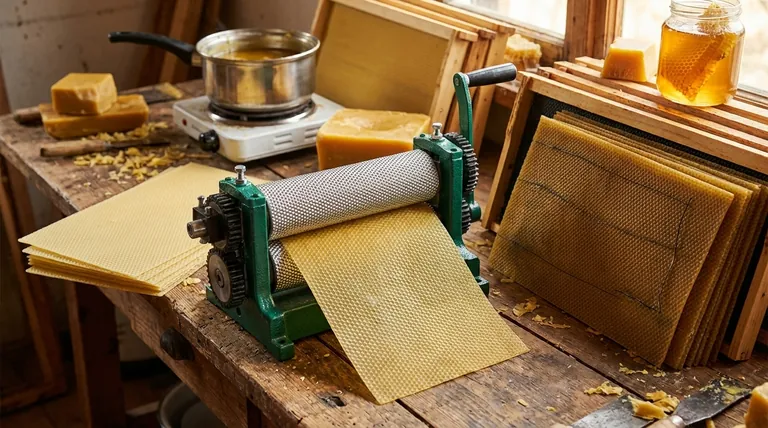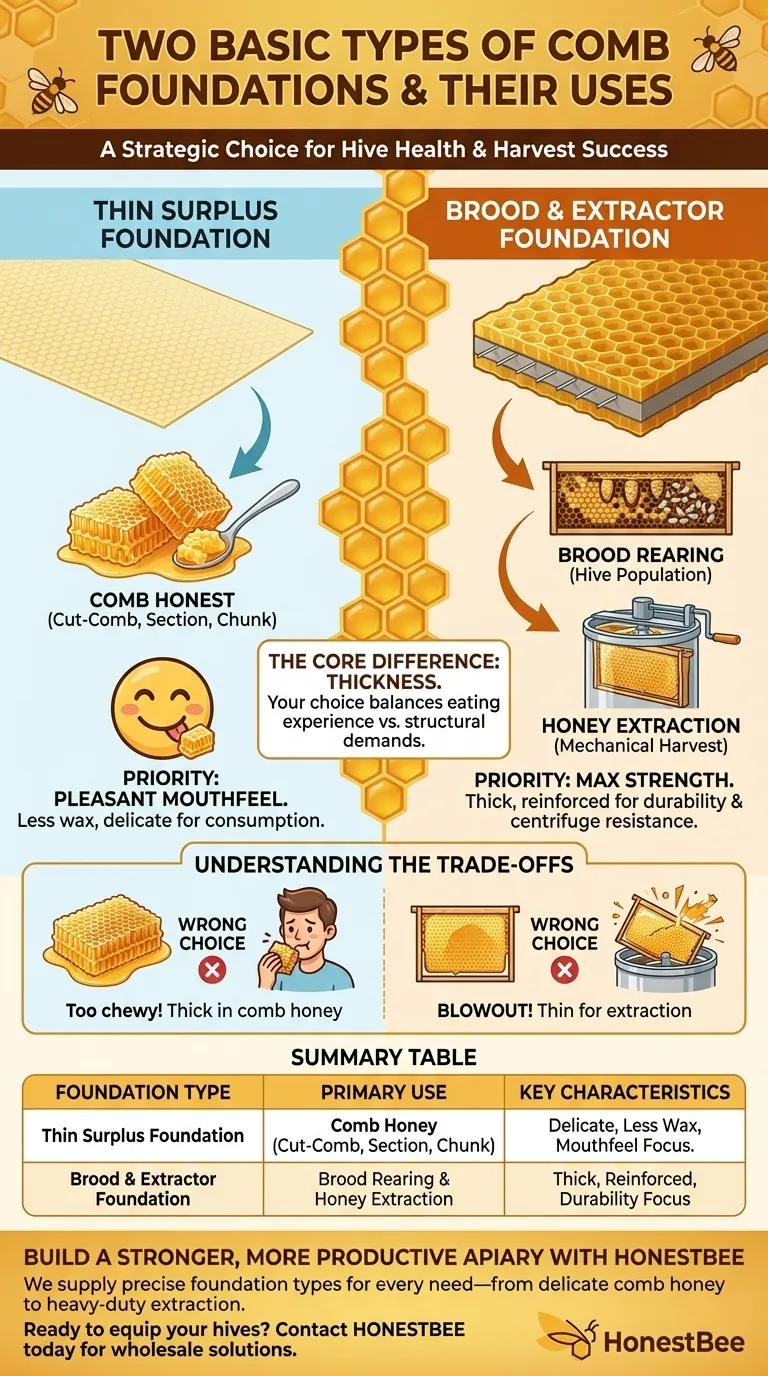At its core, the two basic types of comb foundation are distinguished by their thickness, which dictates their specific use in the hive. A thin, delicate foundation is used when the comb itself will be consumed, while a thicker, more robust foundation is used for brood rearing and honey that will be mechanically extracted.
Your choice of foundation is a strategic decision that balances the eating experience for the consumer against the structural demands of the hive. Thin foundation prioritizes a pleasant mouthfeel, while thick foundation prioritizes long-term durability and strength.

Why Foundation Thickness Matters
Guiding the Bees' Work
Comb foundation is a sheet of beeswax (or plastic coated in beeswax) imprinted with the hexagonal pattern of a honeycomb. It provides a guide, or foundation, for the bees to build upon.
This guide saves the bees a tremendous amount of energy and resources, as producing wax is a costly biological process. It also ensures they build straight, orderly combs that are easy for the beekeeper to inspect and manage.
The Two Primary Functions: Building vs. Eating
The reason for two different foundation types comes down to the ultimate purpose of the comb. Is the comb a permanent structure for raising young bees, or is it a disposable package for honey that people will eat? The answer determines the required thickness.
The Two Foundation Types Explained
Thin Surplus Foundation
This foundation is significantly thinner and contains less wax. It is specifically designed for honey that will be eaten along with the comb.
Its primary uses are for producing section comb honey, cut-comb honey, or chunk honey. Because the consumer will be chewing the wax, less is more. A thin foundation creates a more pleasant, less "waxy" eating experience. Structural integrity is a secondary concern.
Brood & Extractor Foundation
This foundation is thicker, heavier, and often reinforced with internal wires or built on a rigid plastic base. Its purpose is to provide maximum strength and durability.
It is used in two key areas:
- The Brood Chamber: Where the queen lays her eggs and the colony raises its young. This comb must be durable enough to withstand many seasons of use and frequent inspections.
- Honey Supers for Extraction: Where bees store honey that will be harvested using a centrifugal extractor. The foundation must be strong enough to resist being torn apart by the high-speed spinning forces of the extractor.
Understanding the Trade-offs
Using Thick Foundation for Comb Honey
You should avoid using thick, heavy foundation if your goal is to produce comb honey for consumption. The final product will be unpleasantly chewy due to the excessive amount of wax from the thick central spine.
The Risk of Using Thin Foundation for Extraction
Using thin surplus foundation in frames intended for mechanical extraction is a recipe for disaster. The delicate comb will almost certainly disintegrate or "blow out" in the extractor, creating a difficult mess and destroying the valuable drawn comb.
The Problem with Thin Foundation in the Brood Chamber
A thin foundation lacks the structural integrity needed for the brood nest. It can easily warp under heat and the weight of the bees, leading to chaotic comb construction that is difficult to manage and can impede the colony's development.
Making the Right Choice for Your Goal
Choosing the correct foundation is simple when you are clear about your objective for a given hive box.
- If your primary focus is producing comb honey (cut-comb, chunk honey): Use thin surplus foundation in your honey supers to ensure the best possible eating quality.
- If your primary focus is brood rearing and producing extracted honey: Use the thicker, heavier brood or extractor-weight foundation for its essential strength and long-term durability.
- If you are a new beekeeper setting up your first hives: Your priority is building a strong colony, so you will use the thick, durable foundation in your brood boxes.
Matching the foundation to its function is a fundamental skill that ensures both a healthy hive and a successful harvest.
Summary Table:
| Foundation Type | Primary Use | Key Characteristics |
|---|---|---|
| Thin Surplus Foundation | Comb Honey (cut-comb, section, chunk) | Delicate, less wax; prioritizes a pleasant mouthfeel for consumption. |
| Brood & Extractor Foundation | Brood Rearing & Honey Extraction | Thick, heavy, often reinforced; prioritizes durability and structural strength. |
Build a Stronger, More Productive Apiary with the Right Foundation
Choosing the correct foundation is critical for hive health and harvest success. As a trusted wholesale supplier to commercial apiaries and beekeeping equipment distributors, HONESTBEE provides the durable, high-quality foundations your operation depends on.
We help you maximize efficiency and honey quality by supplying the precise foundation type for every need—from delicate comb honey production to heavy-duty extraction.
Ready to equip your hives for maximum performance? Contact HONESTBEE today to discuss your foundation needs and wholesale pricing.
Visual Guide

Related Products
- Manual Beeswax Comb Foundation Machine Wax Foundation Mill Embossing Machine
- Colorful Silicone Beeswax Foundation Mold Mould for Beekeeping
- Food Grade Plastic bee Foundation for Bee Frames
- Beeswax Foundation Sheets Beehive Foundation for Wholesale
- Wooden Queen Bee Excluder for Beekeeping
People Also Ask
- What is a comb foundation mill? A Strategic Tool for Stronger, More Productive Hives
- What is the use of a comb foundation mill? Boost Honey Production with Strategic Hive Control
- Why is it beneficial to make your own beeswax foundation? Gain Control Over Cost, Purity & Hive Health
- What is the importance of soaping the rollers during milling? Prevent Wax Adhesion & Equipment Downtime
- What are the different uses of comb in a bee hive? A Guide to the Hive's Essential Architecture








